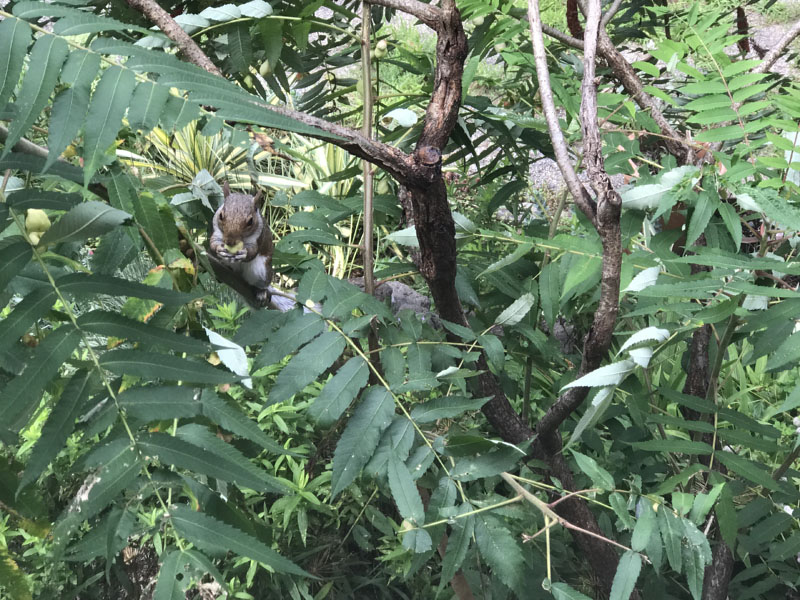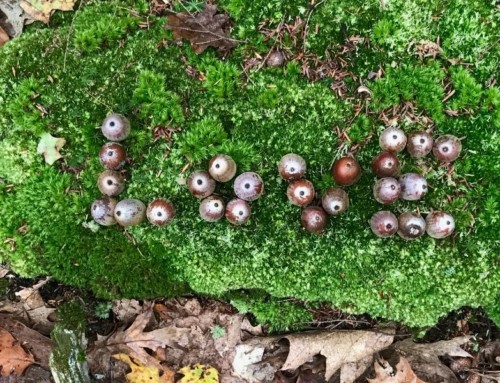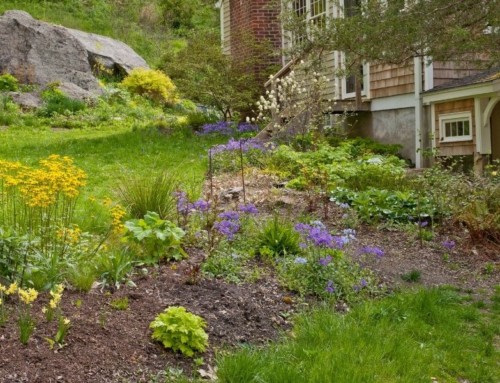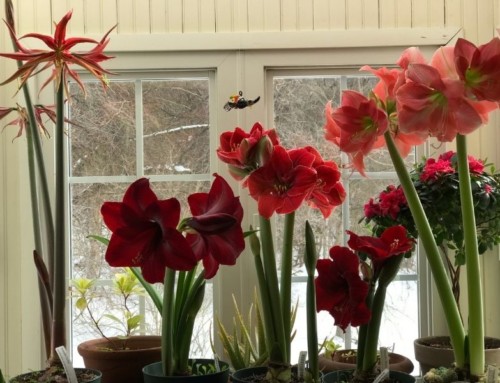Truth be told, the staghorn sumac I planted smack dab in front of my house doesn’t look all that great just now.
Storm battered and bent, dripping with gobs of sumac aphid galls, it has seen better days.
There’s so much life (and entertainment) in these broken branches that I’m not even tempted to replace it with a more conventional specimen tree.
I’ll cut out the worst bent-over main stems and see how it looks. Maybe all the gnarly old trunks need to go. I need to figure out how to selectively prune so it looks good from both indoors and out and doesn’t block my view.
People don’t generally consider sumac’s suckering habit a plus, but it’s an advantage when a tree breaks. Maybe I just need to start over and let fresh suckers fill in the gaps. I do love a clonal colony.
I’ve always loved staghorn sumac’s tropical-looking leaves, young stems resembling velvety antlers (hence its common name), plumy cream-colored flowers, spectacular fall color and fuzzy red berry clusters (only on female plants – they’re dioecious).
It’s a 12 step climb to my front door. Inside, three windows look into the sumac’s top branches.
This is my favorite daylight dining spot because there’s always something going on in that tree that sparks my curiosity.
I had no idea how much interrelated life, drama, trickery, sex, life and death went on in its embrace until the show was right under my nose.
Sumac Pollinators
Since only male flowers produce pollen and female sumac flowers are on separate plants, pollinating go-betweens are needed.
In June, staghorn sumac (Rhus hirta, formerly R. typhina) flower panicles buzz with all manner of pollinators – bees, notably mining bees and bumble bees, wasps and flies, along with occasional nectar-sipping moths and butterflies.
Bee expert Heather Holm cites research in her award-winning book Bees: An Identification and Native Plant Forage Guide (Pollination Press), that found more bees visit male plants in the morning, when their flowers produce pollen.
Neither male nor female flowers produce much, if any nectar in the morning.
Then, in the afternoon, female flowers secrete nectar, attracting those pollen-carrying bees. Pollen brushes off on female reproductive organs, enabling pollination. Good trick!
Caterpillars and More
All manner of insects make themselves at home in staghorn sumac, from leaf-break to post leaf-drop.
Red-banded hairstreak butterflies prefer to lay eggs on the underside of fallen sumac leaves, a good excuse not to rake them up. Small carpenter bees excavate nesting/overwintering tunnels in the soft pith inside broken branches.
Entomologist Doug Tallamy tallies 54 species of moth and butterfly larvae (caterpillars) feeding on staghorn sumac leaves.
Sawflies lay eggs that hatch into caterpillar-like leaf eaters. Leaf-rolling weevils pierce the leaf, lay an egg and roll the leaf around it.
With so much soft-bodied protein living on sumac, it’s a feast for birds. Occasional bird feeding frenzies are the tip-off that something juicy is growing, but I can’t often tell what.
Every year it’s something new. One August day two years ago, a bunch of juncoes appeared and started pulling apart balls of glued-together leaves.
When I pulled one apart to see what they were eating, I found tiny caterpillars and lots of frass (caterpillar poop). Whatever the were, they must have been good.
This year, sumac aphid galls are the main attraction. They apparently don’t compromise the health of the plant and are part of a surprising life cycle.
Sumac aphids congregate on the undersides of leaves, each female laying a single egg. The leaf grows around the egg, providing food and protection inside a leathery pouch (the gall).
The aphid hatches inside and reproduces asexually (parthenogenesis). The gall splits open in late summer, releasing several generations of winged females, which burrow into nearby moss, reproduce some more and recolonize sumacs the next season.
This year the cycle may be broken.
I thought the only squirrel ever smart enough to get to the bird feeder over my front steps had gone away when I took the feeder inside.
But it’s back. There it is, day after day, retrieving pink galls from hanging leaves, one at a time. It climbs back up to a good perch, splits open the gall and eats the fat yellow aphids inside.
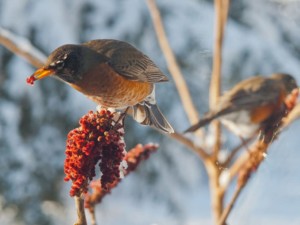 Edible Berries for Birds – or People
Edible Berries for Birds – or People
Harvest and use (or dry) crimson red sumac berries (technically drupes) for tangy “sumac-ade,” jelly or sumac-infused cocktails soon after they ripen in summer. They’re hairy berries, so strain the liquid to remove irritating hairs before consuming.
But I prefer to leave most of the berry clusters on the plant for winter color and bird food.
Because sumac berries are a less-preferred food source, I get to enjoy their cheery presence for many months. Late in the season, they’re a survival food. Winter birds and early spring arrivals flock to polish them off.
A tree that nothing eats might make a more impressive focal point – but I’m plenty impressed with how much life one sumac can support – and how much entertainment it provides.
